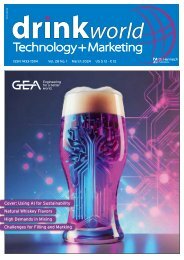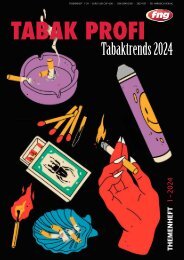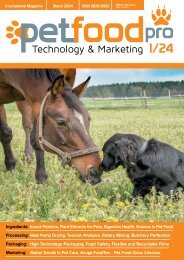food Marketing & Technology 3/2022
food Marketing & Technology is the international magazine for executives and specialists in the food industry.
food Marketing & Technology is the international magazine for executives and specialists in the food industry.
- No tags were found...
Create successful ePaper yourself
Turn your PDF publications into a flip-book with our unique Google optimized e-Paper software.
Events<br />
non-profit initiative myclimate. Both<br />
business partners and consumers<br />
increasingly expect information from<br />
<strong>food</strong> manufacturers about the climate<br />
aspects of their products. The desire<br />
to act is also growing in the fishing<br />
industry itself. But: “Those responsible<br />
in small and medium-sized enterprises<br />
in particular are asking themselves<br />
what they can do in practical terms<br />
to protect the climate,” says Sabine<br />
Wedell, MESSE BREMEN project<br />
manager for fish international. That’s<br />
why she has given the topic a lot of<br />
space in the program of the industry<br />
get-together, which is unique in<br />
Germany, and has attracted renowned<br />
speakers for specialist presentations<br />
and discussions.<br />
Reducing the carbon footprint:<br />
adding value through co-products<br />
The benchmark for climate impact is<br />
the “carbon footprint” of a company<br />
or its product. “When evaluating a<br />
product, you have to look at the climate<br />
impact of its entire life cycle and thus<br />
take into account, above all, how<br />
much energy is consumed at which<br />
point,” says Prof. Norbert Reintjes,<br />
summarizing the principle. For the<br />
footprint of a fish fillet, for example, the<br />
fuel consumption of the fishing vessel<br />
must be taken into account, as well as<br />
the electricity required for processing<br />
and cooling the product, right through<br />
to transpor<br />
and the refrigerated counter at the<br />
point of sale. This overall picture is not<br />
easy to generate, knows the scientist,<br />
who teaches industrial ecology at the<br />
University of <strong>Technology</strong>: “Depending<br />
on the reference with which you<br />
compare products, the result can be<br />
highly different.” For example, when<br />
comparing fish species, “it can be<br />
relevant whether the reference point<br />
is the fresh weight, the weight of the<br />
fillets or the protein content.”<br />
The carbon footprint, created with<br />
the help of expert consultants, can<br />
lead to important course-setting in<br />
the company. “The CO 2<br />
footprint can<br />
usually be reduced by optimizing the<br />
relevant energy consumption,” says<br />
Reintjes. But it could also be reduced by<br />
making better use of the raw material:<br />
“If you turn as many other parts of<br />
the fish as possible into products in<br />
addition to the fillet, the climate impact<br />
of fishing and processing is shared<br />
among these products.”<br />
Currently, Reintjes is pursuing such<br />
projects in Iceland. The “Ocean Cluster”<br />
there is a network of companies that<br />
use leftovers from fish processing for<br />
new products. One successful example<br />
is a company that has developed a<br />
medical product from fish skin for<br />
treating severe skin injuries. “After<br />
just a few years, sales are now already<br />
in the double-digit millions,” Reintjes<br />
reports.<br />
Consulting under the motto “do<br />
the best, offset the rest”.<br />
The myclimate team supports<br />
companies seeking advice in the<br />
complex task of determining their<br />
carbon footprint. Together with them,<br />
the climate protection professionals<br />
then develop ideas, concepts and<br />
measures to reduce the climatedamaging<br />
footprint. In addition,<br />
the non-profit institution offers<br />
companies educational programs for<br />
trainees, employees and, of course,<br />
the management of companies:<br />
“Knowledge is also the prerequisite<br />
for action in climate protection,”<br />
emphasizes Silvia Freeborn.<br />
True to the motto of myclimate “do the<br />
best, offset the rest”, CO 2<br />
emissions<br />
should not be created in the first place,<br />
but avoided. However, since the most<br />
important thing for the climate is that<br />
global emissions decrease in total,<br />
unavoidable emissions can also be<br />
offset. For emissions that cannot be<br />
avoided or have not yet been reduced,<br />
myclimate also offers the possibility<br />
of offsetting in high-quality carbon<br />
offset projects. Classically, these are<br />
projects such as forest conservation<br />
projects or reforestation measures<br />
that ensure that a certain amount of<br />
the greenhouse gas carbon dioxide<br />
is bound. “But these also include<br />
programs right here in Germany,” says<br />
Silvia Freeborn.<br />
For the fishing industry, the entry<br />
point to practical measures for climate<br />
protection is via the myclimate stand<br />
at fish international: “We are available<br />
as a contact throughout the trade fair,”<br />
Silvia Freeborn emphasizes. Sabine<br />
Wedell also knows that knowledge<br />
subsequently leads to action:<br />
“Together with myclimate, we are<br />
developing a climate concept for fish<br />
international and our other events.”<br />
The motivation<br />
here is the same that should drive<br />
the fishing industry: “It’s in our own<br />
interest and expected of participants<br />
and partners.”<br />
fmt<br />
40 <strong>food</strong> <strong>Marketing</strong> & <strong>Technology</strong> • June <strong>2022</strong>


















